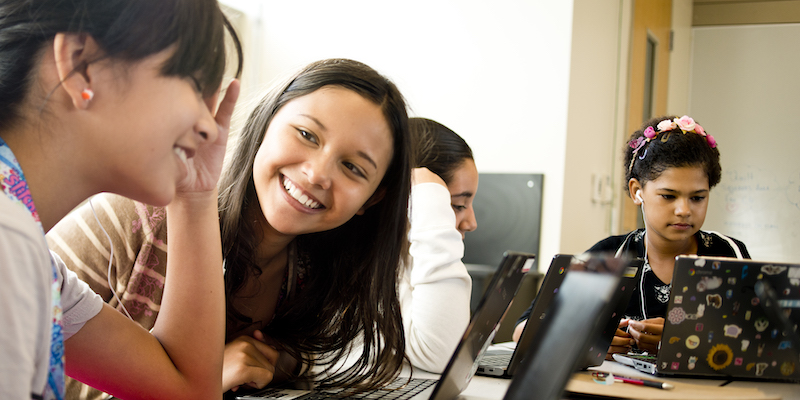A recent synthesis of student surveys during the pandemic, compiled by the Center on Reinventing Public Education, revealed a stark reality about students’ experiences this year. K-12 students report more mental health problems and less sleep time than pre-pandemic, as well as a lack of trusted adults at school to turn to for help.
These experiences leave schools with a big resource challenge to tackle, since students’ needs for support regularly outstrip what professional staff can meet. (Case in point: The average ratio of students to counselors is 464:1, and 1 in 5 students attends a school with no counselor at all.) American Recovery Plan funding is enabling some schools to staff up with student supports in mind, but such an approach is risky, given the temporary nature of that funding.
There’s another approach that schools may be overlooking, though. In a recent podcast interview, school finance expert Marguerite Roza noted, “The idea that the only way to help students is to hire people to help students is a limiting way to think about [ARP] money.” She’s right that relying exclusively on staff won’t produce enough expanded services for students to receive abundant support. But a complementary resource is hiding in plain sight: students’ peer networks.
The benefits are well documented in education research. Friendships and positive peer networks bolster social-emotional well-being, academic progress and career success, and exert a significant influence on students’ academic and career decisions. In short, peer networks represent an important, but underestimated, source of social capital — relationships that help further an individual’s potential and goals.
These benefits could prove crucial in the coming years. So how can schools embrace peer networks as both the foundation for helping students rebound from the pandemic and the fuel behind more longer-term student-centered support systems, particularly those that are chronically hard to scale? Here are four examples:
1. Harnessing near peers to solve for the guidance gap
It’s critical for students to have adults at school whom they trust to ask for help, but peers matter in this regard too. Near peers — older students with more experience — are well-positioned to act as mentors and role models. One example is Student Success Agency, an online platform that connects high school students with virtual near-peer “agents” — playing off the idea that teenagers could benefit from having agents, just like professional athletes and music celebrities do. Near-peer agents, typically college students and young adults, nurture connections with mentees through secure text messages and phone calls where they chat about interests, aspirations, academic and social struggles and more. E.J. Carrion, the agency’s co-founder, said in an interview for a recent report on the power of students’ peer networks that “the majority of [agents’] role is as relationship-builders and reflectors, helping kids find answers within themselves and ignite sparks in their lives.”
One advantage of near-peer mentors is that they can channel information about students’ needs and interests back to schools. For example, as the agents build relationships with students, they share their insights about interests, aspirations and anxieties with educators and counselors through the platform, and work with those adults to coordinate support and opportunities. As a result, the model demonstrates the scale and personalization that can result from collaborative efforts between peer mentors and professional staff.
2. Unleashing peer influence to build college-going culture
Even without near peers, schools still harness the power of peer influence to achieve key goals related to guidance support. For example, PeerForward partners with high schools to create eight-member teams — four juniors and four seniors — to take on the challenge of propelling their peers to college. “In PeerForward, your peer leaders are holding you accountable,” said Gary Linnen, PeerForward’s CEO. “They’re saying, ‘I’ll walk with you. I may not know the answers, but we’ll walk it together. And when you get tired, I’ll say get up. Or I’ll sit with you, if you need me to, to help you get past that moment.’”
One of PeerForward’s primary strategies is engaging young people to plan and execute schoolwide campaigns that help students hit milestones on the road to college. In some schools, these advocacy and influence activities are peer leaders’ primary responsibility. In other, often smaller, schools, peer leaders also act as case managers, regularly checking up on 20 to 30 seniors who are going through the college application process. These peer-to-peer supports have proven critical during the pandemic. According to Linnen, while FAFSA completion rates dropped by 17 percent during COVID, they decreased only 5 percent in schools using PeerForward.
3. Driving academic growth with peer tutors and accountability partners
As many schools look to tutoring as a way to accelerate academic learning post-pandemic, peer tutoring interventions are worth considering as a highly scalable option. Schoolhouse, a new peer tutoring platform created by Khan Academy founder Sal Khan, has been endorsed by state education agencies from Rhode Island to Nevada. While some Schoolhouse tutors are teachers and subject area experts, anyone — including students — can become one by undergoing a peer review certification process. While new, the platform is drawing attention for its ability to verify nonprofessional tutors’ qualifications affordably in high numbers.
For schools not taking the plunge into full-on peer tutoring, students can still provide support by acting as accountability partners who help each other make progress toward their learning goals. At the Forest School, a K-12, diverse-by-design private school in Atlanta, pairs of learners called running partners meet each morning and afternoon to set goals for the day and debrief on progress toward those goals. High schoolers use a “WOOP” protocol — Wish, Outcome, Obstacle, Plan — to set goals and anticipate roadblocks, and record their goals in an online “journey tracker.” These pairs change at least seven times per year, allowing each individual to experience a range of peer relationships and learn which accountability strategies work best.
4. Tackling the teen mental health challenge with peer supports
A final element of student support ripe for peer-to-peer intervention is mental health. National programs like Sources of Strength are training peer leaders to work with adults to support students and reduce suicides, and some schools, like Garey High School in Pomona, California, are starting their own peer counseling centers. These programs are well-regarded: About three-quarters of parents in a national survey agreed that students trained to talk with their peers about mental health would better understand the challenges that teens face, and would improve the odds that teens would speak up about mental health concerns.
Peer leaders in mental health roles often act more as advocates than as counselors. The Sources of Strength program includes training in suicide prevention and awareness campaigns, in addition to preparing students to have conversations with their peers and pull in adults as necessary. Bring Change to Mind, which advocates for ending the stigma and discrimination surrounding mental illness, works with high schools to form student clubs that host conversations about mental health and engage school communities to build comfort in talking openly about the topic. Similarly, the University of Michigan’s Depression Center operates a program, Peer-to-Peer, that educates students about depression and suicide, then equips them to share this knowledge with fellow students. Each program has demonstrated effects, such as reductions in stigma and increased recognition of depression.
Schools considering such models should recognize that while leveraging peer networks make it easier for students to access support, that doesn’t mean peers are always best positioned to tackle complex challenges. Rather than slotting students into what should be staff roles, leaders should continuously assess where peers have a distinct advantage as messengers for key information or as providers of direct support. Where that advantage is absent or unknown, and whenever students face particularly complex challenges, peer supports will need to remain supplements to, not replacements for, professional staff.
Leaders should also be wary of treating peer-to-peer support as an easy route to free labor. For schools interested in helping students earn income through internships or other work-based learning, some formal peer support roles are best seen as an opportunity for more students to earn while they learn. Other peer support roles may be better suited to nonfinancial compensation such as academic credit.
While there’s no perfect or easy solution to making critical student support services available to all who need them, schools will benefit from considering how peer-to-peer approaches can complement traditional approaches to supporting students. Doing so will enable students to access the powerful resources in their peer networks that are too often overlooked by their schools.
This piece originally published on The 74 Million here.


